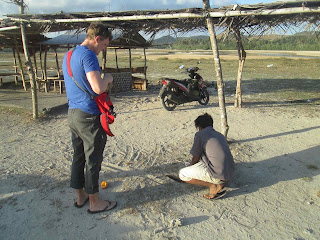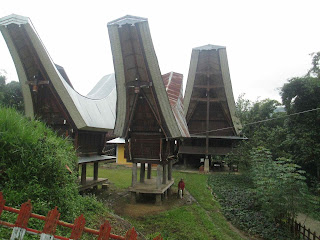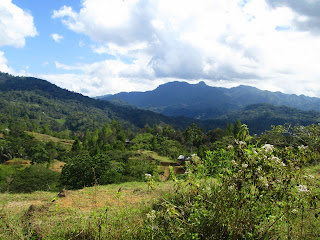Death. In North America we have an expression that only two things are guaranteed in life; death and taxes. In Indonesia tax evasion looks really easy and is essentially a national pastime, but the guarantee of death still holds true. Death, and how we deal with it, how we fear it, how we try to avoid or delay it, and what we believe happens afterwards, has been shaping cultures and ways of life (and death) throughout human history. A rough pattern can be seen in most human populations with a major religion being the dominant influence on what happens after death, as well as providing a set of morals and ethics in which to live our lives by in order to achieve eternal life after death. Or to be reincarnated into a desirable position in the next life. But the pattern is always similar in that death marks only a single moment in our life, yet so much of our life is influenced by the thought of this moment and what lies beyond.
Tana Toraja, a city on the orchid shaped island of Sulawesi, Indonesia has the most fascinating beliefs, traditions and practices with regard to death of any culture I have ever encountered. I was super excited for Melody and Michael to visit Indonesia and explore this fascinating culture with me, and I am excited to share our adventure with you!
Melody: Melody is Scottish and did a one-year exchange at Queen's University while I was completing my Bachelor of Education. We had both applied to live in co-op housing that year and luckily for me we were housemates! Melody is outgoing, adventurous, loves the outdoors and is resilient when faced with adversity (as you'll see later). But most of all Melody stands up against oppression. She is working for a company where she writes articles and runs workshops in classrooms to deal with issues of gender equity, she is very knowledgable and engaged in politics, and she has a very genuine set of morals where she does her best to make the world a better place. I would never argue with Melody, largely because she's more knowledgable and articulate than me on most issues, but also because I have such a high regard for her moral standards that if we were to disagree on something there is a very high chance that I would be the one in the wrong.
Keeping Melody well-fed was a key to success on this trip as she can get a little bit hangry
Michael: This was my first time meeting Melody's boyfriend Mike. Mike is from England but they both studied at Edinburgh and met through swing dancing. Mike is an Engineer and I was impressed by how remarkably fast of a learner he is. He has a very inquisitive nature which appealed to me as a teacher and he made for a great travel companion. He was enthusiastic to ride a scooter, polish his surfing skills, try all the local dishes, and any other activity that was available. However if I had to describe Mike in only 3 words they would be "Mike likes puns". I can't tell you how many times he told the same yolk about how the eggcellent, eggquisite breakfast was eggxactly what he wanted. By the end of the trip my brain was toast, no eggaggeration.
Mike trying to gauge the monetary value in a foreign currency appropriated for climbing a coconut tree, during a high intensity barter scenario
Mike enjoying a well-bartered coconut (or did he overpay? You'll never know Mike)
Tana Toraja
I've had some long journeys throughout my travels in Asia, but getting to Tana Toraja proved to be a very challenging feat. We flew into Makassar in the south of Sulawesi before making our way to the bus station and finding a bus that looked promising to take us to Tana Toraja. It wasn't until an hour after the bus starting moving (which was an 8 hour over-night bus) that we realized we had no idea where to get off. Are there multiple stops? Will we pull up to our destination to see flashing lights and a sign that says this is where you should get off the bus? How are we suppose to identify the guy picking us up who is a friend of a guy I exchanged a few brief messages with? But with razor sharp instincts and a little bit of luck we were able to make it to Tana Toraja where we met our guide Constantino who made the rest of our trip a smooth, pleasant, and culturally fascinating adventure.
Toraja is rich with cultural traditions, and is very beautiful. The traditional houses, called Tongkonan, are shaped like buffalo horns, an animal of great significance in Torajan culture. The house is modelled after the first Tongkonan which was built in heaven. The ancestral tradition is kept and the house serves as a link to the ancestors and to future kin. The house may take a crew three months to build and another month to complete the wood carvings.
A Tongkonan, a traditional Torajan house
The image carved on the door is a buffalo, a symbol of wealth in Torajan culture (wishing many buffalos to the family)
Wood carvings, called Pa'ssura, are used on the walls and interior of houses and are highly symbolic.
The paint used is always a combination of black, white, yellow and red (looks orange here)
Aluk To Dolo, meaning the Way of The Ancestors, is the foundation for all of the cultural and religious traditions practiced by the Toraja people. The culture is incredibly hierarchical with distinct social classes. Only the noble families are allows to decorate all the walls of their traditional houses with wood carvings. In the Way of the Ancestors the colours used to paint the carvings are symbolic. Black symbolizes death and darkness; yellow, God's blessing and power; white, the colour of bone and flesh symbolizing purity; and red the colour of blood symbolizing human life. The geometrical patterns carved are symbolic in their interactions of the four colours, as well as the patterns and images they depict such as the buffalo symbolizing wealth, or an image of a knot and a box symbolizing wishes for the family to live in harmony.
I also mentioned Tana Toraja is very beautiful.
Death
By far the most fascinating aspect of the land of Toraja is the perspective on death. A person's death is the most important day of their life and therefore their funeral marks the most important, and most expensive event in their life. After a family member is deceased they have begun their gradual journey to Puya (the land of souls, or the afterlife). The deceased family member will be wrapped in cloth and live in the house with the family for weeks, months or even years until the funeral ceremony is complete. Yes, the corpse lives in the same room as the family members for months to years. During this time the soul of the individual lingers around the village. Funeral ceremonies are massive feasts attended by thousands of people. The wealthier and higher status the family of the deceased, the more elaborate and expensive the funeral will be. New buildings need to be built for each funeral. Bamboo cannot be reused to build the buildings on the funeral grounds, and each funeral ceremony will use a newly constructed funeral grounds. Afterwards however the bamboo may be reused to build houses. Remember that a funeral is more important than anything else in life.
Here is an image of the newly constructed, and one time use, funeral grounds
The funeral ceremony is a social gathering involving flute music, cultural dances, respects paid to the deceased's family, a feast, and animal sacrifice.
Villagers arriving at the funeral
Guests moving through the central building to be welcomed by the deceased's family
A circle dance and chant which I didn't understand what was happening
Some traditional Torajan funeral clothing
Miniature Torajans and giant foreigners
A pig being carried to the funeral grounds for sacrifice
Exploring the grounds I met this gentleman who is a family member of the deceased. He thanked me for coming to the funeral as foreigners in attendance at the funeral is considered good luck.
Mike, Melody and I were invited to sit in one of the seating areas by a very welcoming family
Again notice the symbolic wood carvings on all the buildings
Just one of the water buffalo whose sacrifice would occur at this funeral.
To elaborate a little more on the animal sacrifice aspect. It should be noted that all of the meat from these animals is used to feed the villagers. All of the guests carry home bags and bags of meat from the funeral ceremony. Many families cannot afford to eat meat year round and so only eat meat which they receive during the funeral season.
The belief behind the sacrifice is that the deceased will need the buffalo to make their journey to Puya (afterlife) and that the more buffalo that are sacrificed the quicker their journey will be. In the past very noble families may sacrifice up to 100 buffalo at one funeral. More typically around 10 water buffalo and 100 pigs and many chickens will be sacrificed. However low class families have strict limits on the number of animals that can be sacrificed at their funerals. The animals are killed with a machete and quickly cleaned with remarkable efficiency. The spilling of blood on Earth at these funerals is considered a sacred act. Funeral ceremonies may also involve buffalo fights or cock fights.
One very interesting aspect is the tremendous amount of debt taken on by the family who holds the funeral. Many of the animals are donated by villagers but these "gifts" are carefully recorded and the debt is then owed by the family of the deceased, whether repayment is monetary or in the form of a donation of an animal in the future. Additionally the family must pay a very expensive tax to the government for the funeral. Families quite literally take on generations of debt in order to ensure a sufficiently elaborate funeral to allow successful passage to Puya for their deceased relative.
Also you might be wondering how buffalo aren't yet extinct in Tana Toraja. Toraja imports many buffalo from other parts of Indonesia and as far away as China.
Graves
Equally rich in tradition is the burial grounds used for deceased Torajans. Bodies are placed in wood coffins and buried in caves, carvings in cliffs or large rocks. These graves can be very expensive and take several months to complete.
Wood carved effigies meant to look like the deceased, called Tau tau, are displayed outside the cave grave or cliff grave. Often times whole families are buried in one grave. The deceased are buried along with all of their possessions that they might need for the afterlife. In modern days that could include the deceased's cell phone or ipad.
Wood-carved effigy or Tau tau of the family who occupies this cliff grave
We also explored a few cave graves.
Coffins hung up in caves
When large enough stones are available a grave may be carved out of them. This of course take a lot of time, especially when you need to decorate the grave with wood carvings.
When a baby dies it is buried in a special tree grave so that the baby may live on through the living tree. There is no ceremony for these funerals. These involve only the mother who has very strict traditions including not looking back after placing the baby in the tree grave.
Melody's stomach migraine
One evening at dinner time Melody got what her doctors have told her is a stomach migraine. There is limited understanding on Google of what these are but if you're familiar with migraine headaches or have ever had or witnessed one you'll understand they are incredibly painful. Unfortunately Melody got one at dinner time which led her to throw up her meal and crouch on the floor of the restaurant in pain for around an hour. Mike and I helped to reassure the restaurant workers that she was not sick from the delicious food they made for us, and Melody felt terrible for being in their restaurant while like this. Eventually we were able to get Melody back to the room and debated going to the hospital. The advantages - at the very least they might be able to provide a pain killer, as well as IV fluids as she was becoming dehydrated rapidly and unable to keep any fluids down. The disadvantages - um, let's just say we were a little hesitant if the medical practices in this indigenous village would be much more scientifically grounded than some of the other practices. No offense.
Ultimately we decided to take Melody to the hospital. I must say that our guide Constantino was a superhero helping us get to the hospital, get a room for Melody, and set her up with some IV fluids. Constantino even slept on a coach outside her room that night in case she needed anything, as well as massaged her with magical oil that helped relieve the pain. It is unknown if the massage or the magical oil is to be given credit for helping to relax the muscles and relieve the pain. And after overnighting in a hospital in a foreign country now that Melody was feeling better it was time for a trek into a local mountainous village. What a trooper!
Trekking
Did I mention that Tana Toraja is beautiful?
Melody taught me the secret to hiking is to "walk quietly". . . something I do not do too well
I wasn't sure if how nervous Mike looked was justified with that completely reasonably wide bridge and fairly minor drop into remarkably calm looking shallow water.
Then I crossed the bridge myself... It's nerve racking
Understandably Constantino needed a break after overnighting at the hospital so his friend Emmanuel and his adorable/mega shy son Melvin took us on the trek instead.
Encountering a friendly local buffalo
Cleverly, these ropes hanging over the rice fields can be pulled to cause bells to ring in order to scare away birds that may try to feed on the rice.
A nice view of a large number of traditional houses
Arriving at the local village
Our own Tongkonan accommodation
Schooling some village punks in barefoot mud soccer
Mike making new friends
Melody keeping a safe distance from a group of girls
This absolutely superb dinner is a Torajan classic. Buffalo meat is cooked for 4-6 hours inside a bamboo shoot over an open fire
Inside the bamboo shoot laying across the fire is the dish we ate in the previous picture
Torajan BBQ
No trek would be complete without a waterfall and a swim in freezing cold water
This is an albino buffalo. Very rare, which means only upper class citizens can sacrifice an albino buffalo at their funeral.
Tana Toraja was an awesome experience. The cultural uniqueness spoke like a fascinating documentary of a distant, ancient culture. Experiencing it first hand and walking amongst the houses, the ceremonies, the graves and of course the people was truly a unique and unforgettable experience.
Lombok and Ubud
With the cultural portion of our trip wrapped up it was time to head to beautiful Lombok and Bali for some beaches, driving scooters on winding roads, sunsets and some monkeys!
Lombok is a great island to give surfing a go
The photo doesn't show it but Melody said I looked cool surfing
Gili Trawangan sunset
Lombok sunset
I had been to Ubud about 4 times before and every time had intended to wake up at 2:00am to do the Mt. Batur morning sunrise hike... but 2:00am and I don't often see eye to eye. With Mike and Melody I finally made it for this morning hike complete with breakfast and coffee at the top of the mountain while enjoying the sun rise.
A visit to Bali wouldn't be complete unless you see some monkeys!
Melody was trying to give the banana to the cute monkey when the rude, aggressive monkey stole it
She was not impressed
And in perhaps the most well-timed photo I've ever taken two monkeys use Mike's arm as an arena to have a vicious battle for banana supremacy. I am happy to report all of his fingers survived the incident.
Thanks again to Mike and Melody for the awesome travel companionship!











































































No comments:
Post a Comment